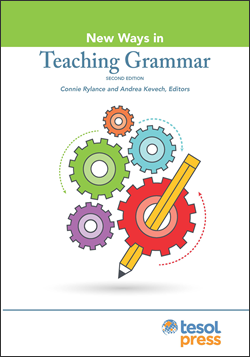 The following activities are from New Ways in Teaching Grammar, Second Edition, edited by Connie Rylance and Andrea Kevech.
The following activities are from New Ways in Teaching Grammar, Second Edition, edited by Connie Rylance and Andrea Kevech.
From Beginning to End
Contributed by Dino Mahoney
Level: Intermediate to advanced
Aims: Use the past tense and joining words in short narratives; develop creative storytelling skills
Class Time: 1 hour
Preparation Time: 30 minutes
Resources: Index cards (or slips of paper)
Students practice the past tense and work on temporal connectors and other transition words by developing stories to connect a first and last sentence.
PROCEDURE
-
Prepare two sets of index cards. Each set should contain enough cards for each group of three to four students:
-
Set 1: Each index card should contain one sentence that could serve as the beginning of a story; all the cards in this set can contain the same sentence. An example beginning might be, “It was a cold, wet Sunday in February, so Georgina thought it would be a good day to stay at home and read a book.”
-
Set 2: Each index card should contain one sentence that could serve as the end of a story. It’s a good idea to have several different possible endings, and the endings should be intriguing. For example, “After that, she decided it was time to move,” or “She never again opened her front door to a stranger.”
-
In class, divide the students into groups of three or four.
-
Give each group two of the prepared cards, one from Set 1 and one from Set 2.
-
Appoint one student in each group as the scribe.
-
Ask each group to create a story that fills in the missing information, making sure to set a time limit, for example, 15 minutes.
-
Circulate among the groups to give feedback as needed.
-
Stop the activity after the time is up and ask the scribes to tell their group’s story.
-
Have the class vote on the best story.
CAVEATS AND OPTIONS
-
Students can write out their stories during class or for homework.
-
Give a list of specific lexical or other items that students must use in their stories, for example:
-
attorney
-
helicopter
-
Inspector Stevenson
-
but before doing that . . .
-
when she realized that . . .
-
the next thing she remembered was . . .
Download this activity (PDF)
Present Perfect Mingle
Contributed by Erin Kuester
Level: High beginner to intermediate
Aims: Practice asking and answering questions using the present perfect
Class Time: 15–20 minutes
Preparation Time: 5 minutes
Resources: Handout (Appendix)
Students mingle, asking and answering questions about their past experiences using present perfect tense. They then work with a partner to share their information.
PROCEDURE
-
Explain that the class is going to learn about their classmates by asking them about things they have or haven’t done in the past.
-
Distribute the worksheet, explaining that they will be walking around the room and talking to each student using the present perfect to ask classmates whether they have or have not done the activity on the handout until they have filled in every square on the worksheet with someone’s name who has answered “yes”
to the question.
Example
Instructor: Li, have you ever broken a bone?
Li: Yes, I have!
Instructor: Wow! Can you write your name in this box? Abdullah, have you ever climbed a mountain?
Abdullah: No, I’ve never climbed a mountain.
Instructor: Oh okay, let me ask you a different question. -
Review the sentences on the handout and entertain any vocabulary questions. Note that because the verbs are in their base form, students will need to supply the past participles.
-
Have students walk around the classroom asking their questions. Circulate to ensure students are using English and to offer feedback or answer questions.
-
Once students have completed their worksheet or sufficient practice time has passed, pair the students and give them a few minutes discuss some of the information they learned. Debrief with the whole class, letting students talk about themselves or their classmates.
Example
Instructor: Okay, who here has sung karaoke?
Wang: I have sung karaoke before! I talked to Aya, and she has sung karaoke, too.
CAVEATS AND OPTIONS
-
For lower level classes, ask students to supply the past participles of verbs before beginning to ask questions.
-
As a follow-up, assign students to write a short paragraph reporting on the most surprising or interesting information they learned.
-
Leave space on the worksheet for students to fill in a question of their own creation.
Download this activity and Appendix (PDF)
|
Purchase New Ways in Teaching Grammar, Second Edition, at the TESOL Bookstore |
These activities may be reproduced for educational purposes only.
© TESOL International Association.
| Next Article |